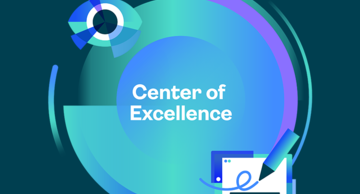Center of excellence: What is it and why create one?

Today, organizations have recognized the value of eSignatures and the need to transform their agreement processes to a fully digital model. If you look at how eSignatures are used across all parts of the enterprise, whether it's B2C, B2B, or B2E applications, there are hundreds of eSign use cases across business units and departments. However, as all of these different groups adopt electronic signatures, it is common for the enterprise to end up with overlapping solutions in-house. This makes it difficult to lower the total cost of ownership (TCO), facilitate compliance, and deliver consistent customer experiences.
To achieve these benefits, it's important to find ways to leverage technology effectively. With that goal in mind, financial institutions and business enterprises are building centers of excellence within their organization to optimize the use of a particular technology, whether that is eSignature, eForms, or the many other tech tools at their disposal.
What is a center of excellence?
A center of excellence (COE) is a discipline within an organization with a specific focus.
The concept of a center of excellence is to build out key processes, establish a methodology, and develop expertise across the enterprise. It is typically based on a technology, critical process, new skill, or application – to help the organization adopt it and become efficient at it.
Good examples of a COE would be systems, applications, and products; digital transformation; or automation. It is important to recognize that effective technology use, as guided by a center of excellence, is to ensure it will be adopted across the entire organization.
At the outset, processes are introduced for launch and adoption across the enterprise. As the application matures, so do the opportunities within the organization. As in the digital transformation example of eSignatures and eForms, processes generally start in one functional area or with one group of people, and then scale to other parts of the business. The value proposition of a COE is minimal unless you go enterprise-wide.
To be effective, a center of excellence must also evolve and strive for continuous improvement. It is an iterative process that demands input from all functional areas and matures to support those different functional areas as things change. For example, a key aspect of developing your center of excellence could be establishing a competency center and/or a capability center for the new technology or processes. That competency center or capability center can have a narrow focus area to help facilitate project management, coordinate team members' efforts, and leverage business intelligence.
Over time, your center of excellence will evolve into a shared service model. As best practices are found, initial feedback is gathered, and word of the technology’s effectiveness spreads to new lines of business (LOB), the COE is well positioned to facilitate widespread adoption across the enterprise. What’s more, this allows the organization to centralize the technology and allow each line of business to consume the application as a service without resorting to localized, on-premise deployments.
Why would an organization consider creating a COE?
Standardization. As an organization grows and matures, the need for a COE becomes more obvious. With numerous lines of business all trying to independently create efficiency, improve processes, and leverage technology, inevitably, the LOBs would unknowingly create tech redundancies, utilize different vendors, and create further incompatibilities between departments. The COE ensures consistency across the enterprise — one solution, one provider. This is especially important if the impetus for the COE is vital to the organization’s success.
Within any organization, there are various functional areas. The COE establishes a standardized process for adoption and maintenance.
Take, for example, a new regulatory requirement that affects a business overall. To ensure compliance and consistency, the COE establishes the processes and solutions around each channel of delivery, such as the branch, call center, mobile, and web. Best practices and adoption procedures are defined for each channel – not lines of business.
The COE becomes the de facto standard for operations – regardless of the solution.
The concept of a center of excellence is to build out key processes and expertise across the enterprise. It is typically based on a technology, a critical process, or an application – to help the organization adopt that process, increase competitiveness, and become efficient at it.
What is the value to the organization?
It establishes a best-in-class operation AND it’s a scalable and repeatable process. It becomes the organizational standard. In doing so, intelligence from channels of operation that have already adopted practices reduces the learning curve for those new to the organization. Documented processes can be easily rolled out to new channels.
A typical COE focuses on operational excellence. Can it do more?
There are four important benefits of centers of excellence:
- Adoption - It creates a framework for the enterprise to adopt change
- Implementation – It builds the blueprint and is responsible for implementation
- Maintenance – It provides a structure for both maintenance and evolution
- Expertise – It creates a team of internal consultants to help digitize legacy processes and offer guidance
Who benefits from the COE?
The creation of a center of excellence is designed to benefit all stakeholders – employees, customers, and shareholders – as the processes virtually always support a mission-critical function or requirement that creates business value.
What are the drivers for a COE?
The main drivers for a COE are actually the same two things that typically drive change in many organizations:
- The customer experience – A desire to provide an omnichannel experience in which the same user experience across all channels and touchpoints in the organization
- Operational efficiency – The drive to streamline operations, increase speed to market, ensure optimization, and reduce costly overhead in time, paper, human resources, and money
How does one go about creating a COE?
The starting point is a realization that the enterprise needs some manner of digital and remote capabilities to survive and move forward. Management first needs to understand how the business will benefit from the process. From there, they commit to assigning resources.
A thriving COE must have executive sponsorship and buy-in from leaders throughout the organization. They will be asked for their commitment to implement new best practices, and they’re going to be solicited for their input and perspective as the process evolves.
Needs must be defined. Using eSignatures and eForms as our digital transformation example, you’d need a roadmap of digital workflows throughout the organization. Perhaps establish a digital task force within the enterprise to address learning and development, adoption and rollout, and focus on each business channel.
It’s a big question: "How do we transform ourselves into a digital business?" You need both a top-down and bottom-up approach to create a successful center of excellence.
More COE best practices and success factors:
Cross-discipline COE team: The goal of the COE is to centralize expertise to address business needs. Doing so requires the involvement of multiple skill sets and subject matter experts (SMEs) in specific areas and from multiple teams. Ensure your COE has comprehensive knowledge and training around the technology in every necessary area of expertise with a dedicated team.
Consistency and governance: It’s important to prepare for the unexpected when utilizing your COE. Standardize the deployment and operation process between LOBs and use cases, so that when unexpected issues or distractions arise, the team can deliver a targeted response and resume the typical response. This will minimize disruptions.
Which leaders typically participate?
Often the center of excellence initiative is led by the Chief Information Officer (CIO), or if the organization has one, the Chief Experience Officer.
You need representation across the functional areas of the organization to truly be successful. Establishing a COE has to be a collaborative and cohesive effort. Failure is often a result of an assumption that IT owns and operates this without input and alignment on key business processes – hence the need for true collaboration.
What’s involved in maintaining it?
Ongoing funding is key – and often how the COE is perceived internally makes a big difference. It’s not a physical area like a training center, and it’s certainly not a help desk!
Executive sponsorship is critical, as is the commitment to growth and change. Circumstances will change, technology will advance, regulatory compliance issues will evolve – and the COE needs to be fluid and nimble enough to change with it. As well, organizations must acquire the skill sets necessary for change and evolution, and they need to be agile.
Maintaining a center of excellence is a journey, not a destination. Revisit the team and processes on an ongoing basis to ensure that the COE continues to effectively support the organization.
Is there access to the COE or does it operate more like a task force that sets standards?
Since a center of excellence is not a physical location or shared facility, you must have virtual representation across the enterprise. If you’re a global organization, for instance, you’ll need representative advocates worldwide.
Headquarters typically identifies the need and creates the COE, supports it, and ensures it’s promoted throughout the enterprise. Collaboration at every level is critical.
At the end of the day, it’s about what drives new business. New standards of excellence and operating models established by the COE are often transformational to the business and must be embraced across the enterprise to be impactful.
How does the organization share learnings from the COE across the organization?
That’s a great question. It’s imperative to always measure what’s working and what’s not. Then you know what needs modifying and altering. Communication is a critical part of any COE undertaking. It gets people on your side, and that buy-in is necessary for success. It’s important to share successes internally and form partnerships across the organizational structure.
Generic learnings can be shared with other organizations, of course.
How do you measure success?
Measuring success is different for different organizations. It always depends on what you’re trying to achieve. You should set goals at the start and decide how you’re going to measure them. To be truly effective, there needs to be an understanding of what is being measured and more importantly, why.
Without any type of metrics to demonstrate ROI, the COE in all likelihood will fail. Part of the function of the COE is to build the roadmap, creating the framework and design points.
It’s always healthy to measure specific KPIs and do a check at specified milestones. This will ensure that funding for this area will continue.
What do all successful COEs have in common?
All successful centers of excellence do these things right:
- They start with an impending event and a desire to move the entire organization to a new framework of business (like digital transformation)
- They understand it will be an enterprise-wide initiative
- They’re solving an overall enterprise problem
- They have executive understanding and buy-in
- They have funding
- They see its importance for the business and elevate that internally
- They have defined ROI and can measure/prove organizational impact
- They are approached as a collaborative undertaking
- They are viewed as an iterative process
- They are capable of evolving
To sum it up in four words: collaborate, iterate, adopt, evolve. In a post-pandemic world, this has become second nature. Collaboration has become more prevalent in organizations to drive their success.
Unexpected benefits of a COE
At the Bank of Montreal, the consulting function of the COE has helped remove traditional barriers to entry such as legal challenges and business case development. This has helped drive adoption, and the shared insight from each LOB helps the next operate more effectively.
COEs, rather the key individuals within them, help new business units save time, energy, and money by not repeating the same mistakes, sharing learnings, and avoiding similar pitfalls. The entire operation launches more efficiently and adoption of new processes is accelerated.




